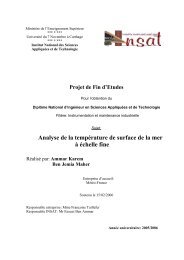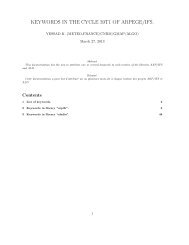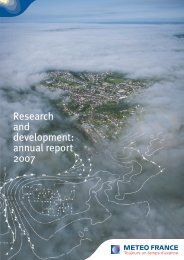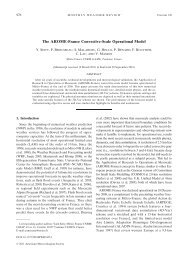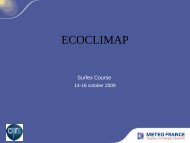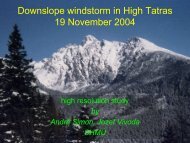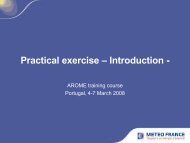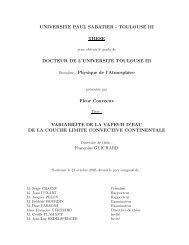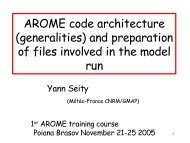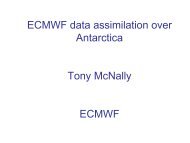Météo-France ALARO & AROME activities
Météo-France ALARO & AROME activities
Météo-France ALARO & AROME activities
Create successful ePaper yourself
Turn your PDF publications into a flip-book with our unique Google optimized e-Paper software.
Internal CNRM <strong>ALARO</strong>/<strong>AROME</strong> workplan - Feb 2005<br />
Internal CNRM workplan with identified resources<br />
on the <strong>ALARO</strong> and <strong>AROME</strong> models<br />
for the 1st half of 2005<br />
F. Bouttier, 10 February 2005<br />
This document is based on large contributions by G. Hello, J.-F. Geleyn, D. Giard, C. Lac, and takes into<br />
account the reorientation of the <strong>ALARO</strong>-10km project in Setp/Oct 2004 and extensive discussions<br />
following the « TCWGPDI » Prague workshop on Nov. 2004. It clarifies the short-term R&D activites of<br />
Météo-<strong>France</strong> staff at CNRM, Toulouse, specifically devoted to the model components of the <strong>ALARO</strong>-<br />
10km and <strong>AROME</strong> projects. The relevant sections of the Aladin-2 workplan are 1a and b, 2b and c, 4a, b<br />
and c. For questions please contact the main project managers directly : J.-F. Geleyn for <strong>ALARO</strong>-10km<br />
(jean-francois.geleyn@chmi.cz) and F. Bouttier for <strong>AROME</strong> (bouttier@meteo.fr). The differences between<br />
this paper and the Aladin-2 workplan are (1) only work done inside CNRM is mentioned, (2) only work<br />
with actually identified resources is mentioned, (3) the level of workplan detail is finer, (4) only modelspecific<br />
topics are covered i.e. assimilation etc are outside the scope of this document.<br />
Here, <strong>AROME</strong> and <strong>ALARO</strong> <strong>activities</strong> are not distinguished according to longterm<br />
objectives: virtually all <strong>activities</strong> cited here will be beneficial for both<br />
projects in the long run. The distinction is that of immediate expense: since both<br />
projects have tight deadlines, they are actually competing for manpower, so that<br />
each item below is explicitly attributed to the project to which it is most critical.<br />
Most actions deal with short-term priorities, which does not imply that longer-term issues are being<br />
neglected, they will be solved in due time, which may take many years. It is hoped that this plan as seen<br />
from Météo-<strong>France</strong> in Toulouse matches the needs of everyone else in the ALADIN community. Comments<br />
and questions are always welcome at bouttier@meteo.fr and we will do our best to include suggestions for<br />
alternative strategies in our future internal workplans.<br />
Note 1: a longer-term roadmap has also been proposed by for the externalisation of the surface in<br />
ARPEGE/ALADIN/<strong>ALARO</strong>. This plan partly overlaps with that one (in part G)<br />
Note 2: the work done for ARPEGE is not mentioned, even if it is going to be useful for <strong>ALARO</strong> or<br />
<strong>AROME</strong>, so as not to confuse the issues.<br />
Note 3: in a future step, this document should be extended to include a list of (much needed) commitments<br />
of workforce from Aladin partners in order to speed up the work.<br />
1
Internal CNRM <strong>ALARO</strong>/<strong>AROME</strong> workplan - Feb 2005<br />
I. Short-term CNRM workplan on the <strong>AROME</strong> model<br />
1. Cleanup of the <strong>AROME</strong> experimental environment<br />
aim: more efficient experimental tools in order to carry out the required preoperational testing<br />
of <strong>AROME</strong>, development towards an <strong>AROME</strong> software that can run operationally and be<br />
exported.<br />
1a. Preparation of initial conditions and lateral boundary coupling files<br />
aim: a simpler forecast launching system (script, namelist, Olive configuration)<br />
actions:<br />
– port the surface physiography preparation software prep_pgd from PC Linux to<br />
VPP (P. Le Moigne, 0.5 month)<br />
– remove the need to run the extract_arpege utility by directly loading the required<br />
surface fields in Arpege/Aladin memory from the externalized surface. Implies<br />
altering I/O routines of the externalised surface software (S. Malardel and V.<br />
Masson, total 1 month)<br />
– gather the operations into a single script that can do either the complete domain<br />
configuration and model initialisation, or the date-dependent model initialization<br />
only (i.e. the equivalent of 927 to avoid remaking the physiographies on each<br />
run, but the daily updating of time-dependent surface evolving fields will not yet<br />
be implemented in 2005) (J.-M. Audoin and collaborators, total 2 months).<br />
– (further simplifications will be developed in the 2nd half of 2005)<br />
1b. Post-processing<br />
aim: make the Arome model output suitable for generation of the most important<br />
products of full-POS. Currently, full-POS requires access to some surface fields which<br />
are no longer accessible in the FA file output because the surface has been externalized.<br />
actions:<br />
– compute from the surface files the required fields (such as Tsurf), insert them<br />
into the <strong>AROME</strong> FA files, check that the essential fullPOS functionality is<br />
recovered for plotting (F. Bouttier, total 0.5 month)<br />
– extend the feature to the T2m etc. which can be computed directly by the surface<br />
software, so that fullPOS only does the horizontal part of the interpolations on<br />
these fields (R. El Khatib, total 0.5 month)<br />
– make fullPOS work as expected on new upper-level fields: TKE, NH fields,<br />
microphysics fields, in particular with respect to postprocessing noise and<br />
clipping of non-physical values (G. Hello and R. El Khatib, total 1 month)<br />
2
Internal CNRM <strong>ALARO</strong>/<strong>AROME</strong> workplan - Feb 2005<br />
2. <strong>AROME</strong> technical development<br />
aim : solve short-term problems<br />
2a. Phasing of cycle 30<br />
aim: put the complete Fortran code of the <strong>AROME</strong> prototype into an official<br />
ARPEGE/ALADIN cycle, with the physics phased on the latest Méso-NH release. Partly<br />
done in cy29t1, some cleaning and the ensuing validation remain to be done. (Y. Seity and<br />
K. Yessad, total 2 months)<br />
2b. <strong>AROME</strong>/MésoNH mutual phasing<br />
aim: maintain full <strong>AROME</strong>/MésoNH software consistency. The procedure has been<br />
clarified on paper, the appropriate MésoNH release Masdev4.6 + $n 'bug' release will be<br />
available in March and shall be copied under ClearCase, then <strong>AROME</strong> has to be<br />
revalidated with respect to MésoNH changes. (C. Lac, S. Malardel, Y. Seity, F. Bouttier,<br />
COMPAS/GCO, total 1.5 month)<br />
2c. Externalized surface (core issues)<br />
aim: cleanup the quick-and-dirty physics calling interface, by moving the call to the<br />
surface inside the processing by NPROMA packets. The feasibility of using the MésoNH<br />
$n (i.e. subfield instancing for gridnesting) feature has been demonstrated for the<br />
initialization and the call to the parametrisation. It must be reimplemented using the new<br />
MésoNH instancing technique ($n’s have been phased out), and extended to writing the<br />
fields. (visiting 6-month scientist to be identified, until then it will require about 1<br />
month/semester of work from G. Hello, S. Malardel and V. Masson)<br />
2d. NH dynamics<br />
aim: fix known weaknesses with the d4 + Predictor/Corrector NH configuration. Most of<br />
the work will probably be done by the Aladin-NH experts.<br />
- the biperiodization of the d3 term at each timestep is prohibitive. It shall be done<br />
in a simpler way, or removed by making d3 a coupled variable. (problem<br />
submitted to F. Vana and R. Brozkova, we are awaiting instructions)<br />
- results are sensitive to the choice of the ND4SYS switch, which should change<br />
the algorithm but not the result. To be clarified (task overseen by P. Bénard and<br />
G. Hello)<br />
- check whether the Digital Filter Initialisation is compatible with the P/C scheme<br />
(issue submitted to J. Vivoda)<br />
- investigate stability problems apparently linked to the LRDBBC Bottom<br />
Boundary Condition option (issue raised by Y. Seity)<br />
3
Internal CNRM <strong>ALARO</strong>/<strong>AROME</strong> workplan - Feb 2005<br />
3. <strong>AROME</strong> validation<br />
aim: to gather more experience with the physical strength and weaknesses of the model.<br />
3a. MAP<br />
aim: run POI2B, for which initial conditions are already available, there is some prior<br />
experience in the community (N. Asencio in GMME, Y. Wang in Austria). Results to be<br />
presented at the next MAP meeting (Croatia, summer 2005) (Y. Seity, 3 months)<br />
3b. Routine forecasts<br />
aim: run lots of short-range forecasts on small domains in order to highlight unforeseen<br />
problems, and to give bench forecasters a flavour of what is to come. Need to define<br />
domains, outputs, scores, evaluation procedure.<br />
3c. Horizontal diffusion<br />
aim: to investigate suspiciously noisy convective structures. The new SLHD diffusion of F.<br />
Vana shall be finalized and tested. (G. Hello and K. Yessad, total 1.5 month)<br />
4. Training and management<br />
Aim: expand the use of Arome.<br />
4a. Stage de modélisation of the ENM School of Meteorology<br />
Supervision of ENM students for testing several Arome options on existing 2D and 3D test<br />
cases. (Y. Seity)<br />
4b. Aladin visit<br />
Supervision of L. Kullman to configure and test Arome on Hungary (5 weeks around<br />
March, by Y. Seity and G. Hello)<br />
4c. Stage de fin d'études ITM of the ENM School of Meteorology<br />
Supervision of D. Raspaud to diagnose diabatic contributions to the T1 Christmas 1999<br />
storm, and response of Arome to TSR large-scale forcing perturbations on the Gard<br />
flooding case. (January to June 2005, by P. Arbogast and G. Hello)<br />
4d. Coastal ocean coupling<br />
Supervision of G. Casagrande to compare Arome and Aladin surface flux quality in terms<br />
of forcing of a coastal ocean model. (3 months starting in February, by S. Malardel and G.<br />
Hello)<br />
4e. Deported Aladin work<br />
Help T. Kovacic to rerun Arome-10km test cases (G. Hello).<br />
Help J. Cedilnik to run grey-zone tests intercompared with Aladin (G. Hello).<br />
Help D. Banciu in case there are further requests for intercomparisons on Romania (G.<br />
Hello).<br />
4
Internal CNRM <strong>ALARO</strong>/<strong>AROME</strong> workplan - Feb 2005<br />
4f. Deported Hirlam work<br />
Minor help on e.g. NH or GFL (on top of R. El Khatib and J.-D. Gril's work)<br />
4g. Aladin training course on Arome in Romania<br />
Will require heavy preparation work.<br />
5. 1D model<br />
aim: to have a well-working 1D model in order to undertake thorough work on physics.<br />
Requires phasing the existing 1D model with Arome (3 months of S. Malardel to finish the<br />
work started with S. Sbii)<br />
6. Diagnostics<br />
aim: to define and implement diagnostics specific to Arome, allowing basic comparisons of<br />
physics behaviour between Méso-NH, Arome and Aladin.<br />
Requires a prior specification work before a substantial coding, in relation with the work on<br />
equations and APLXX (A and B below) (J.-M. Piriou, 2 months)<br />
II. Short-term CNRM workplan on the <strong>ALARO</strong> model<br />
The following tasks are sorted following J.-F.'s Geleyn classification in processes (filières in<br />
French). Most processes will extend over several years, here we only mention the actual shortterm<br />
work. It usually corresponds to the first column of J.-F. Geleyn's table of priorities (dated<br />
9 Jan 05), but not always, some longer-term actions are starting early.<br />
A. « Equations » process<br />
aim: to clarify the relationship between the « governing equations » used in each<br />
mesoscale model. It would be nice to have a clean documentation of that.<br />
action: The plan is to have a set of documentation papers to depict the following:<br />
• reference set of continuous multiphasic equations (partly written by S. Malardel)<br />
• how <strong>AROME</strong> approximates the reference set (partly written by J. Stein)<br />
• how ALADIN approximate the reference set (partly written by M. Tudor)<br />
• how Méso-NH approximates the reference set (partly written by S. Malardel)<br />
• the discretisation of the application of the diabatic tendencies to the NH<br />
dynamical core (some has been written by B. Catry)<br />
This action has no tight deadline. Some substantial work has already be done by M. Tudor<br />
(work coordinated by S. Malardel who will contribute 1 month this semester)<br />
5
Internal CNRM <strong>ALARO</strong>/<strong>AROME</strong> workplan - Feb 2005<br />
B.« Tendencies » process<br />
aim: to gather all physics routines under a single calling interface that will facilitate<br />
intercomparison of individual parametrisations, and to improve the I/Os of the physical<br />
parametrisations in order to be able to call them in any order. It could be useful for<br />
Hirlam.<br />
action: rewrite routine APL<strong>AROME</strong> into a new, general physics calling subroutine<br />
(suggested name: APLXX), that encompasses the old APLPAR, using the following<br />
steps: (the actual order of operations might be a bit different)<br />
1. Upgrade APLPAR to make it able to call the new operational<br />
ARPEGE/ALADIN physics. (PROC team)<br />
2. Copy APL<strong>AROME</strong> under the name APLXX and import the pieces of APLPAR<br />
necessary to call the ARPEGE/ALADIN physics from it.<br />
3. Convert the existing output of Méso-NH physics routines (tendencies) into<br />
fluxes, introducing dummy fluxes where necessary (all the fluxes are not<br />
computed in Méso-NH), in such a way that the integration of fluxes done on<br />
CPTEND leads back to the exact, original Méso-NH tendencies. It will involve<br />
computing dummy fluxes (to set to zero and to document carefully !) for the<br />
conversion terms that are not available from the parametrisations. (This step<br />
should not involve any change to the code that is shared with MésoNH) (G.<br />
Hello)<br />
4. check that APLXX reproduces the results of both APLPAR and APL<strong>AROME</strong>.<br />
5. (the computation of the missing fluxes from the MésoNH physics will be<br />
introduced later according to future progress of item E(i) )<br />
who: G.Hello, J.-M. Piriou and E. Bazile with supervision of F. Bouyssel and Y.<br />
Bouteloup, total 3 months.<br />
C. « Diagnostics » process<br />
aim: to extend the DDH (Diagnostics par Domaines Horizontaux) diagnostic package<br />
to the <strong>AROME</strong> model as much as possible. It would provide a nice, familiar working<br />
environment to physics people who are used to DDH in ARPEGE and ALADIN.<br />
action:<br />
1. Implement the required modifications to the delta-m=1 option (pertaining to the<br />
status of precipitating mass in the governing equations) when the model particle<br />
is assumed to move with the barycentric velocity (essentially, it is a<br />
simplification of the Cp computation), following the paper by B. Catry.<br />
2. Add the new Lopez and <strong>AROME</strong> microphysics phase changes to the DDH set of<br />
diagnostics<br />
who: J.-M. Piriou, 1 month (+ 1 month in 2nd half of 2005) (how far this goes towards<br />
fulfilling the <strong>ALARO</strong> project requirements shall be checked before summer 2005)<br />
6
Internal CNRM <strong>ALARO</strong>/<strong>AROME</strong> workplan - Feb 2005<br />
D. « Quasi-dynamical » process<br />
aim: to clean the use of the delta-m option in the whole code, as a first step towards a<br />
thermodynamically consistent dynamics/physics coupling: application of the diabatic<br />
tendencies to the NH dynamical core, and TKE diffusion (A. Trojakova).<br />
action: remove the delta-m=1 code from relevant places in the old ACCVIMP<br />
convection scheme and in 'experts only' places of the dynamics, it only shall only<br />
remain in the Cp computation.<br />
who: Y. Seity with the help of K. Yessad, 1 month (+1 month in 2nd half of 2005)<br />
E. « Méso-NH physics adaptation» process<br />
aim: to facilitate the planned interfacing and diagnostic work on the <strong>ALARO</strong> side, some<br />
modification of the <strong>AROME</strong>/Méso-NH common library would be nice. Three actions<br />
have been requested and will be dealt with by the MésoNH community as stated below:<br />
(i) Output new diagnostic terms from the microphysics in order to have a complete set of<br />
diagnostic fluxes between all condensates. This development must follow the existing<br />
MésoNH diagnostic code structure. As much as possible will be done given the<br />
resources, starting with the easier bits. (C. Lac and S. Malardel, total 1 month, will<br />
required continuing work later)<br />
(ii)Implement the transport of heat by precipitation. This is acknowledged as a current<br />
weakness of Méso-NH physics, although there is no clear scientific consensus on<br />
what happens in nature and how it should be parametrized. A tentative heat exchange<br />
term will be developed within the next year or so (action managed by J.-P. Lafore).<br />
The nature of this term shall be advertised as soon as possible in order to check that it<br />
is compatible with the thermodynamical equilibrium hypotheses implied by the<br />
chosen equations in process « A » above. (costing is evaluated at 2 months of code<br />
analysis by J.-P. Pinty and S. Malardel, then 1 month of actual coding by S. Malardel,<br />
probably during 2nd half of 2005)<br />
(iii) Clean the hard-coded references to the leap-frog timestepping inside the<br />
parametrisations. This a matter of code cleaning, which will be undertaken during<br />
2005. (C. Lac, 0.5 month)<br />
F. « ARPEGE physics adaptation» process<br />
aim: to alter the new ARPEGE/ALADIN physics in order to make it follow the old<br />
physics principles of interfacing and diagnosis.<br />
work:<br />
• Change the ARPEGE prognostic TKE diffusion code so as to have the TKE on<br />
full model levels<br />
• Split the TKE parametrisation so that the actual diffusion is done by the old<br />
ACDIFUS routine<br />
7
Internal CNRM <strong>ALARO</strong>/<strong>AROME</strong> workplan - Feb 2005<br />
• Check whether there are issues of stabilities at varying resolutions<br />
who: feasibility study by Y. Bouteloup, coding work with E. Bazile, total 1 month.<br />
G. « Surface » process<br />
aim: to speed up the ARPEGE/ALADIN plugging in of the externalised surface so that<br />
<strong>ALARO</strong> can use it. This is tricky because specific technical development is needed, and<br />
some inter-team coordination needs to be organised in CNRM, this process must be split<br />
into smaller subtasks.<br />
work packages:<br />
• develop the surface/diffusion implicit coupling in the ARPEGE/ALADIN<br />
Fortran code (P. Marquet et al, 5 months for the ARPEGE-Climate model, this is<br />
the most urgent)<br />
• implement new features into the external surface code and files, mainly the<br />
ALADIN and ARPEGE geometries (P. Le Moigne et al, 3 months, coordination<br />
with GMAP, GMME, DSI)<br />
• enforce compatibility with the non-model operational ARPEGE/ALADIN<br />
configurations, including FullPos, surface and upperair assimilation. Need to<br />
start with an inventory of requirements (R. El Khatib, F. Taillefer, F. Bouyssel,<br />
J.-M. Audoin, etc., coordination with GMAP, GMME, DSI, total 6 months)<br />
There are two additional processes, « Symmetric compatibility » and « Grey zone<br />
physics », which are not done in Toulouse except perhaps for some help in running 1D<br />
intercomparisons between Alaro and MésoNH (help from S. Malardel and G. Hello)<br />
_______<br />
On top of these <strong>ALARO</strong> actions, limited supporting work by GMAP/PROC and G. Hello<br />
will be given (typically, to run tests: e.g. on radiation). G. Hello shall also publish the corrected results<br />
from the <strong>AROME</strong>-10km test cases.<br />
8
Internal CNRM <strong>ALARO</strong>/<strong>AROME</strong> workplan - Feb 2005<br />
III. Implied workload on CNRM staff<br />
The unit is the person.month; multiple-person actions are either shared or allocated to the first cited<br />
person, depending on what is most likely to happen. The action numbers are given between square<br />
brackets. The names are sorted in alphabetic order. For G. Hello, S. Malardel and Y. Seity we also<br />
mention the particularly large number of 'minor' tasks (management and training) which will add<br />
up to a few extra person.months . For most people there will be some added workload for the<br />
ALADIN meeting in Slovakia (June 05), too.<br />
L. Auger 0.5 [G]<br />
J.-M. Audoin 2 [1a] + 2 [G]<br />
E. Bazile 2 [B] + 0.5 [F]<br />
Y. Bouteloup 0.5 [F]<br />
F. Bouttier 0.5 [1b]<br />
F. Bouyssel 0.5 [G]<br />
G. Casagrande 3 [4d]<br />
R. El Khatib 0.5 [1b] + 2 [G]<br />
J.-D. Gril 1 [G]<br />
G. Hello 0.5 [1b] + 0.5 [2c] + 1 [3c] + 1 [B] + 12 'minor' tasks<br />
C. Lac 0.5 [2b] + 2 [Ei] + 0.5 [Eiii]<br />
P. Marquet 5 [G]<br />
V. Masson 0.5 [1a] + 0.5 [G]<br />
P. Le Moigne 0.5 [1a] + 3 [G]<br />
S. Malardel 0.5 [1a] + 0.5 [2b] + 0.5 [2c] + 3 [5] + 1 [A] + 5 'minor' tasks<br />
J.-M. Piriou 2 [6] + 1 [C]<br />
Y. Seity 1 [2a] + 0.5 [2b] + 3 [3a] + 1 [D] + 7 'minor' tasks<br />
F. Taillefer 1 [G]<br />
K. Yessad 1 [2a] + 0.5 [3c]<br />
(visitor on surface interface 6 [2] if recruited)<br />
(GMME work [E] on Méso-NH physics and operations-oriented extra work on the<br />
externalised surface [G] not yet quantified)<br />
Conclusion: this adds up to about 39 person.months, when one includes holidays and the<br />
overhead of 'small' tasks, this amounts to about 7 full-time staff, including more than 2 on<br />
<strong>ALARO</strong>-specific work.<br />
9



